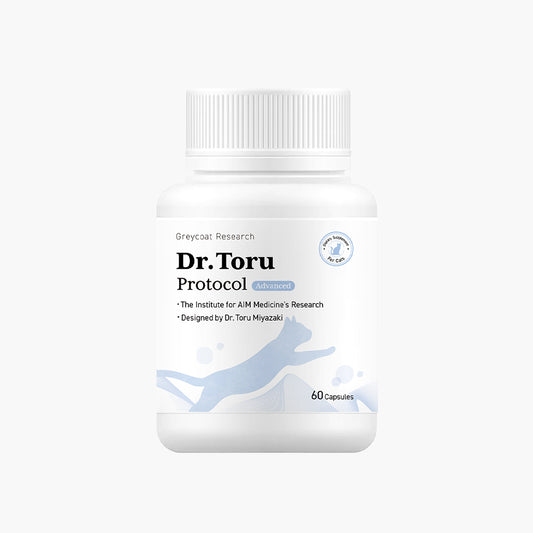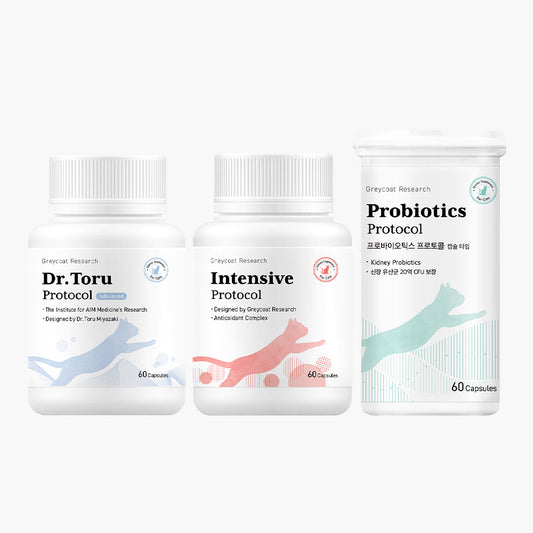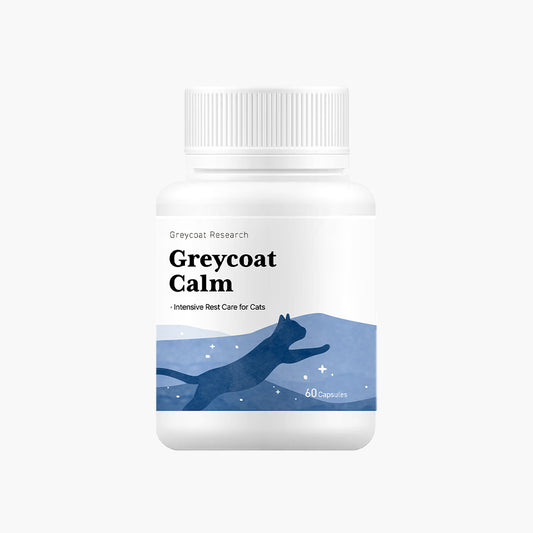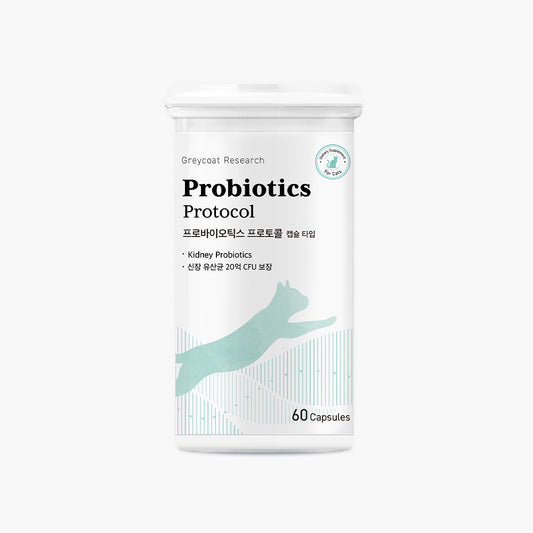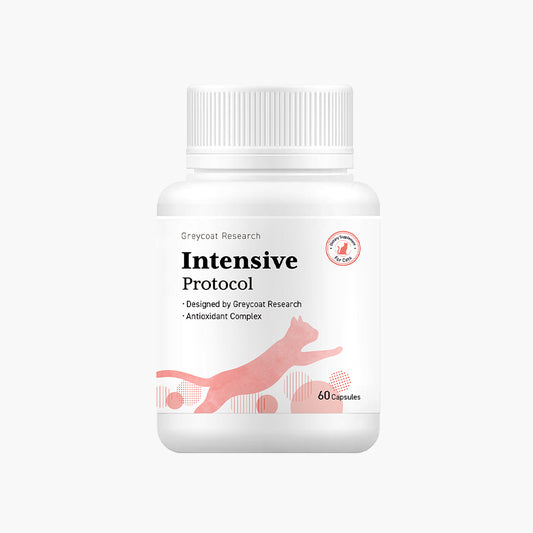
Lernen Sie die heutige Katze kennen!
- Name: Tigger
- Alter: 16 Jahre
- Geschlecht: Männlich (kastriert)
- Gewicht: 10 lbs (ca. 4,5 kg)
- Blutwerte: 2,5 (Kreatinin), 33 (Harnstoff/BUN)
- Anmerkungen: Hat CKD im Stadium 1 und leidet unter starker Arthritis. Wird von seiner Betreuungsperson mit einer proteinreichen Diät gefüttert.
Pflegeperson
Mein Kater Tigger leidet unter sehr starker Arthritis und muss bis zu neun verschiedene Nahrungsergänzungsmittel pro Tag einnehmen.
Das ist nicht nur für ihn sehr belastend, sondern auch für mich – daher frage ich mich, ob es möglich ist, die Anzahl der Präparate zu reduzieren.
Könnte ich eventuell einige der derzeitigen Produkte durch Präparate von Greycoat Research ersetzen?
Und wenn ja – würde mir das helfen, bei den Supplement-Kosten zu sparen?
Greycoat Research
Viele der Katzen, die wir im Rahmen unserer Beratung betreuen, nehmen täglich eine Vielzahl an Nahrungsergänzungsmitteln und Medikamenten ein – oft zwischen 5 und 12 Präparate.
Diese Anzahl zu reduzieren kann nicht nur die Kosten senken, sondern auch dabei helfen, einen stabileren und stressfreieren Fütterungsplan einzuhalten.
Daher unterstützen wir Sie sehr gerne bei diesem Anliegen.
Könnten Sie uns bitte mitteilen, welche Nahrungsergänzungsmittel Sie Tigger derzeit geben und in welcher Dosierung?
Pflegeperson
Hier ist alles, was ich Tigger derzeit gebe:
- Zahnpflegepulver (Dental Plaque Remover) – $14,60
- Omega-3 (flüssig) – $39,99
- Probiotika (Pulver) – $39,99
- Mariendistel zur Nierenunterstützung – $22,99
- Antioxidantien – $61,99
- Gelenkpräparat (Kapsel) – $19,99
- Gelenkpräparat (flüssig) – $22,99
- Ipakitine (Phosphatbinder) – $33,49
- Porus One (Toxinbinder) – verschreibungspflichtig
Das alles reicht jeweils für zwei Monate.
Der Phosphatbinder und Toxinbinder sind nötig, weil Tigger proteinreiches Futter bekommt – daran würde ich ungern etwas ändern.
Die beiden Gelenkpräparate bekommt er wegen seiner starken Arthritis.
Greycoat Research
Auf Grundlage unseres bisherigen Gesprächs empfehlen wir, die folgenden Anpassungen an Tiggers Supplementplan vorzunehmen:
Diese Präparate können sicher weggelassen werden:
- Zahnpflegepulver (Dental Plaque Remover)
- Mariendistel zur Nierenunterstützung (Milk Thistle Renal Supplements)
Wir sind der Ansicht, dass Tigger diese Präparate in seinem aktuellen Gesundheitszustand nicht benötigt.
Von den folgenden Präparaten ist nur eines erforderlich:
- Gelenkpräparate (Kapsel)
- Gelenkpräparate (flüssig)
- Antioxidantien
Nur das erste Gelenkpräparat (Kapsel-Form) sollte ausreichen.
Die beiden Gelenkpräparate enthalten überlappende Inhaltsstoffe, daher empfehlen wir, bei nur einem davon zu bleiben.
Außerdem enthält das Intensive Protocol von Greycoat Research sowohl antioxidative als auch entzündungshemmende Komponenten.
Es kann somit Ihr aktuelles Antioxidantien-Präparat ersetzen – und bietet Tigger darüber hinaus zusätzliche Vorteile.
Folgende Präparate sollten ersetzt werden:
- Probiotika (Pulver)
- Omega-3 (flüssige Tropfen)
Sie können Ihre aktuellen Probiotika durch unser Produkt Probiotics Protocol ersetzen.
Im Fall von Omega-3 empfehlen wir, von der flüssigen Tropfenform auf Kapseln umzusteigen.
Omega-3-Öle sind anfällig für Oxidation bei Luftkontakt, was im Körper der Katze entzündliche Reaktionen auslösen kann.
Kapseln sind deutlich stabiler und weniger anfällig für Verderb, was sie zu einer sichereren Wahl macht.
Beim Kauf von Omega-3-Produkten achten Sie bitte darauf, dass sie mindestens 1000 mg DHA und EPA pro Portion enthalten.
Bei den folgenden Präparaten (und dem Futter) ist Vorsicht geboten:
- Ipakitine (Phosphatbinder)
- Porus One (Harnpflichtiger-Toxinbinder)
- Proteinreiches Katzenfutter
Tiggers BUN-Wert von 33 ist im Verhältnis zu seinem Kreatininwert von 2,5 relativ hoch.
Zudem besteht das Risiko, dass der Kreatininwert von 2,5 in kurzer Zeit deutlich ansteigen könnte.
Daher empfehlen wir, Tigger von seiner proteinreichen Ernährung auf eine Nierendiät umzustellen.
Wir verstehen jedoch, dass Tigger möglicherweise sehr an seine derzeitige Ernährung gewöhnt ist.
Falls er eine vollständige Umstellung nicht akzeptiert, schlagen wir vor, Nierendiät-Futter schrittweise mit seinem aktuellen Futter zu mischen.
In diesem Fall wäre es nicht mehr nötig, ihm Ipakitine (Phosphatbinder) zu geben.
Da sein BUN-Wert jedoch weiterhin erhöht ist, und falls er auf seinem proteinreichen Futter besteht, sollte Porus One als Toxinbinder unbedingt weiter verabreicht werden.

